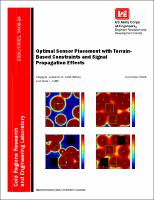Please use this identifier to cite or link to this item:
https://hdl.handle.net/11681/5557Full metadata record
| DC Field | Value | Language |
|---|---|---|
| dc.contributor.author | Vecherin, Sergey N. | - |
| dc.contributor.author | Wilson, D. Keith | - |
| dc.contributor.author | Pettit, Chris L. | - |
| dc.date.accessioned | 2016-03-21T16:38:13Z | - |
| dc.date.available | 2016-03-21T16:38:13Z | - |
| dc.date.issued | 2008-12 | - |
| dc.identifier.govdoc | ERDC/CRREL TR-08-24 | - |
| dc.identifier.uri | http://hdl.handle.net/11681/5557 | - |
| dc.description | Technical Report | - |
| dc.description.abstract | The optimal sensor placement problem, as considered here, is to select the types and locations of sensors providing coverage at high-value terrain locations while minimizing a specified cost function. The cost function can reflect various disincentives, such as the actual cost of the sensors, the total number of sensors, and the probability that the sensor will be found and disabled by hostile actors. The probability of detection (at a certain probability of false alarm) is assumed to depend on terrain conditions and obstructions, and may be arbitrarily complex. Two strate-gies are described for finding the minimal number of sensors, and their locations that will satisfy given coverage preferences. The first is heuristic in nature and based on placing sensors one-by-one where the probability of detection is minimal. This strategy offers a rapid, but suboptimal solution. The second strategy is based on solution of the binary linear programming problem. For the case of fine spatial resolution that leads to large matrix dimensions, a fast algorithm for approximate solution of this problem is developed. The key features of this study are: 1) the probabilis-tic framework of sensor performance, 2) incorporation of the coverage preferences in the placement strategy, 3) realistic modeling and incorpora-tion of the sensors’ probability of detection, 4) multimodal sensor support, 5) a strict formulation of the optimal coverage problem, 6) development of a fast algorithm for approximate solution of the binary linear program-ming problem, and 7) introduction of a safe-mode concept. | - |
| dc.format.extent | 45 pages/509.5 Kb | - |
| dc.publisher | Cold Regions Research and Engineering Laboratory (U.S.) | - |
| dc.publisher | Engineer Research and Development Center (U.S.) | - |
| dc.relation | http://acwc.sdp.sirsi.net/client/en_US/search/asset/1001741 | - |
| dc.relation.ispartofseries | ERDC/CRREL ; TR-08-24 | - |
| dc.rights | Approved for Public Release; Distribution is Unlimited | - |
| dc.source | This Digital Resource was created in Microsoft Word and Adobe Acrobat | - |
| dc.subject | Detectors--Location | - |
| dc.subject | Binary control systems | - |
| dc.subject | Digital signatures--propagation | - |
| dc.title | Optimal sensor placement with terrain-based constraints and signal propagation effects | - |
| dc.type | Report | - |
| Appears in Collections: | Technical Report | |
Files in This Item:
| File | Description | Size | Format | |
|---|---|---|---|---|
| CRREL-TR-08-24.pdf | 509.5 kB | Adobe PDF |  View/Open |